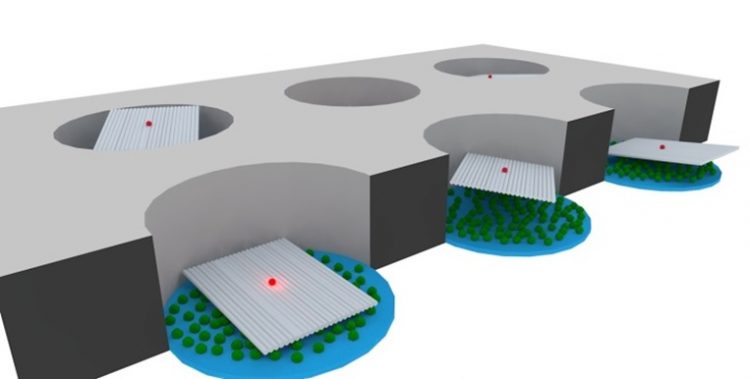DNA nano-adapters: stimulus for single-molecule DNA sequencing

Immobilization strategy: DNA origami (grey rectangles) equipped with a fluorescent dye (red) occupy the small holes in the metal film (ZMWs) in a way that only one adapter fits per cavity. TU Braunschweig
This development is of relevance especially for DNA sequencing, which is considered the key technology for the analysis of inherited diseases. The latest results are presented in the current issue of the journal “Nano Letters”.
For DNA sequencing, individual nucleotides are analyzed which are the building blocks of DNA. “Monitoring the incorporation of single nucleotides into a full DNA strand in real-time is a revolutionary method”, Prof. Philip Tinnefeld explains. “It’s almost a live broadcast”.
Special proteins, the so-called DNA polymerases, incorporate the nucleotides in a zipper like fashion to build a double stranded DNA strand. In order to observe this process and extract the order of nucleotides, scientists employ special cover slides. A glass slide is coated with a thin metal film that contains tiny holes, so-called zeromode waveguides (ZMWs).
“The challenge for this application is to equip each of these nano-holes with exactly one polymerase that utilize the nucleotides”, Prof. Philip Tinnefeld says. Usually, these biomolecules are deposited randomly in the ZMWs, which results in many empty ZMWs while others contain multiple polymerase molecules. Even for the optimal situation, only 37 % of the holes can be used, as the expert for Nano-Bio-Sciences explains.
Coupling and positioning of molecules
His research group now achieved a more efficient usage of the ZMWs by developing a new binding strategy. For this, the nano-experts from the Institute for Physical and Theoretical Chemistry in the Laboratory of Emerging Nanometrology (Braunschweig University of Technology) could use their experience of working with the so-called DNA origami technique: the Braunschweig scientists literally fold precisely fitting structures from single viral DNA strands.
The nano-adapters were designed such that exactly one DNA origami can bind in every ZMW. The nano-adapters additionally provide docking points for functional units, like fluorescent dyes or the polymerase molecules that are used for DNA sequencing. “With our novel strategy, we connect single molecules via DNA origami with the lithographically fabricated ZMWs. This procedure can improve the efficiency of DNA sequencing and also be beneficial for applications in other areas of research like molecular electronics”, Prof. Tinnefeld summarizes.
About the project
This research project of the NanoBioSciences group of Prof. Philip Tinnfeld (Institute for Physical and Theoretical Chemistry) was conducted at the new Laboratory of Emerging Nanometrology of the Braunschweig University of Technology and was funded by a Starting Grant of the European Research Council (SiMBA).
Publication
E. Pibiri, P. Holzmeister, B. Lalkens, G.P. Acuna, P. Tinnefeld (2014):Single-Molecule Positioning in Zeromode Waveguides by DNA Origami Nano-Adapters – Nano Lett.
Contact
Prof. Philip Tinnefeld
Dr. Guillermo Acuna
Institut für Physikalische und Theoretische Chemie
Arbeitsgruppe NanoBioSciences
Laboratory of Emerging Nanometrology
Technische Universität Braunschweig
Hans-Sommer-Strasse 10
38106 Braunschweig
Tel: 0531 391 5330
E-Mail: p.tinnefeld@tu-braunschweig.de
www.tu-braunschweig.de/pci
www.tu-braunschweig.de/mib/lena
Media Contact
All latest news from the category: Life Sciences and Chemistry
Articles and reports from the Life Sciences and chemistry area deal with applied and basic research into modern biology, chemistry and human medicine.
Valuable information can be found on a range of life sciences fields including bacteriology, biochemistry, bionics, bioinformatics, biophysics, biotechnology, genetics, geobotany, human biology, marine biology, microbiology, molecular biology, cellular biology, zoology, bioinorganic chemistry, microchemistry and environmental chemistry.
Newest articles

High-energy-density aqueous battery based on halogen multi-electron transfer
Traditional non-aqueous lithium-ion batteries have a high energy density, but their safety is compromised due to the flammable organic electrolytes they utilize. Aqueous batteries use water as the solvent for…

First-ever combined heart pump and pig kidney transplant
…gives new hope to patient with terminal illness. Surgeons at NYU Langone Health performed the first-ever combined mechanical heart pump and gene-edited pig kidney transplant surgery in a 54-year-old woman…

Biophysics: Testing how well biomarkers work
LMU researchers have developed a method to determine how reliably target proteins can be labeled using super-resolution fluorescence microscopy. Modern microscopy techniques make it possible to examine the inner workings…





















